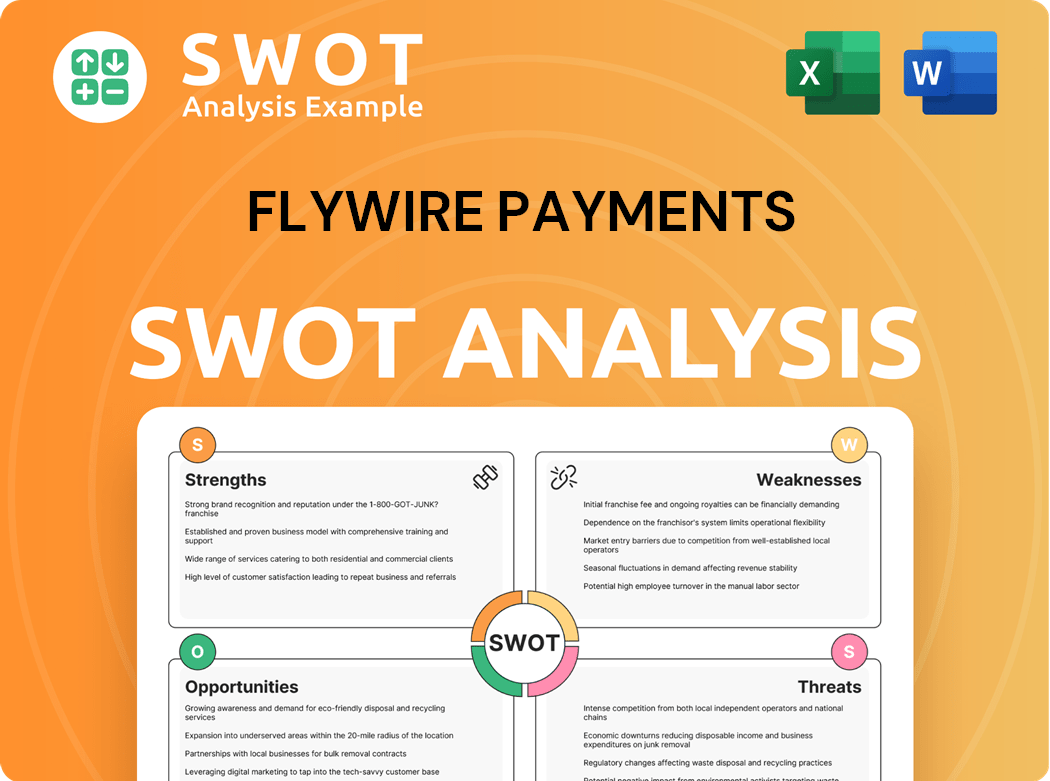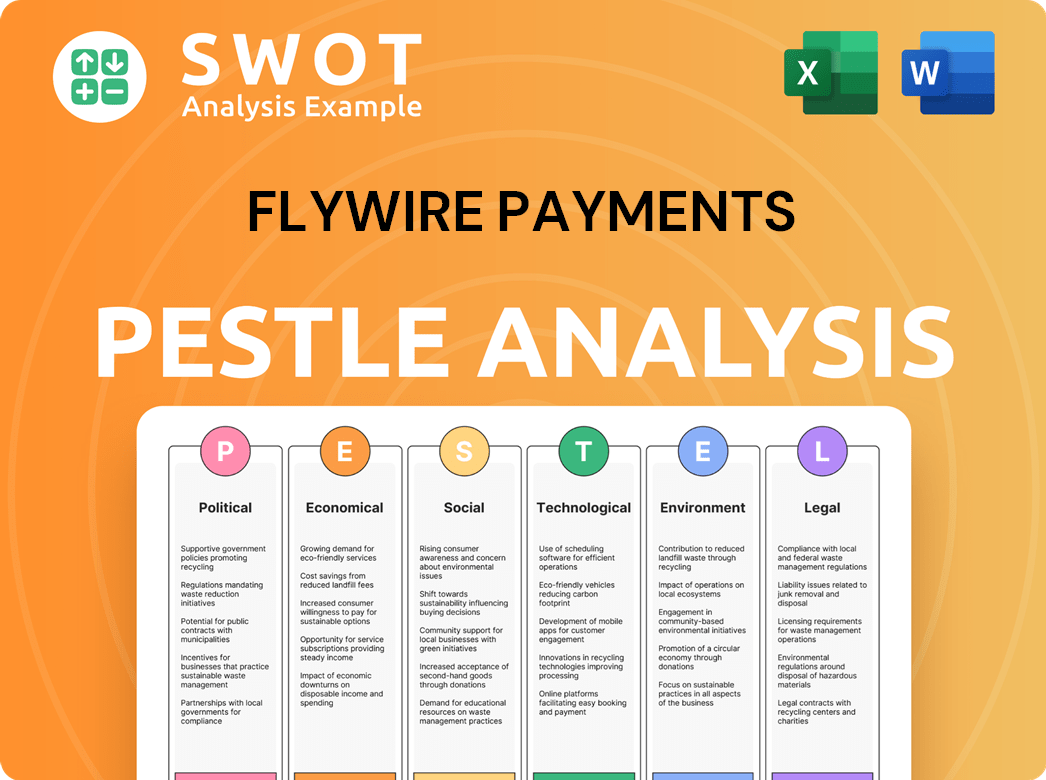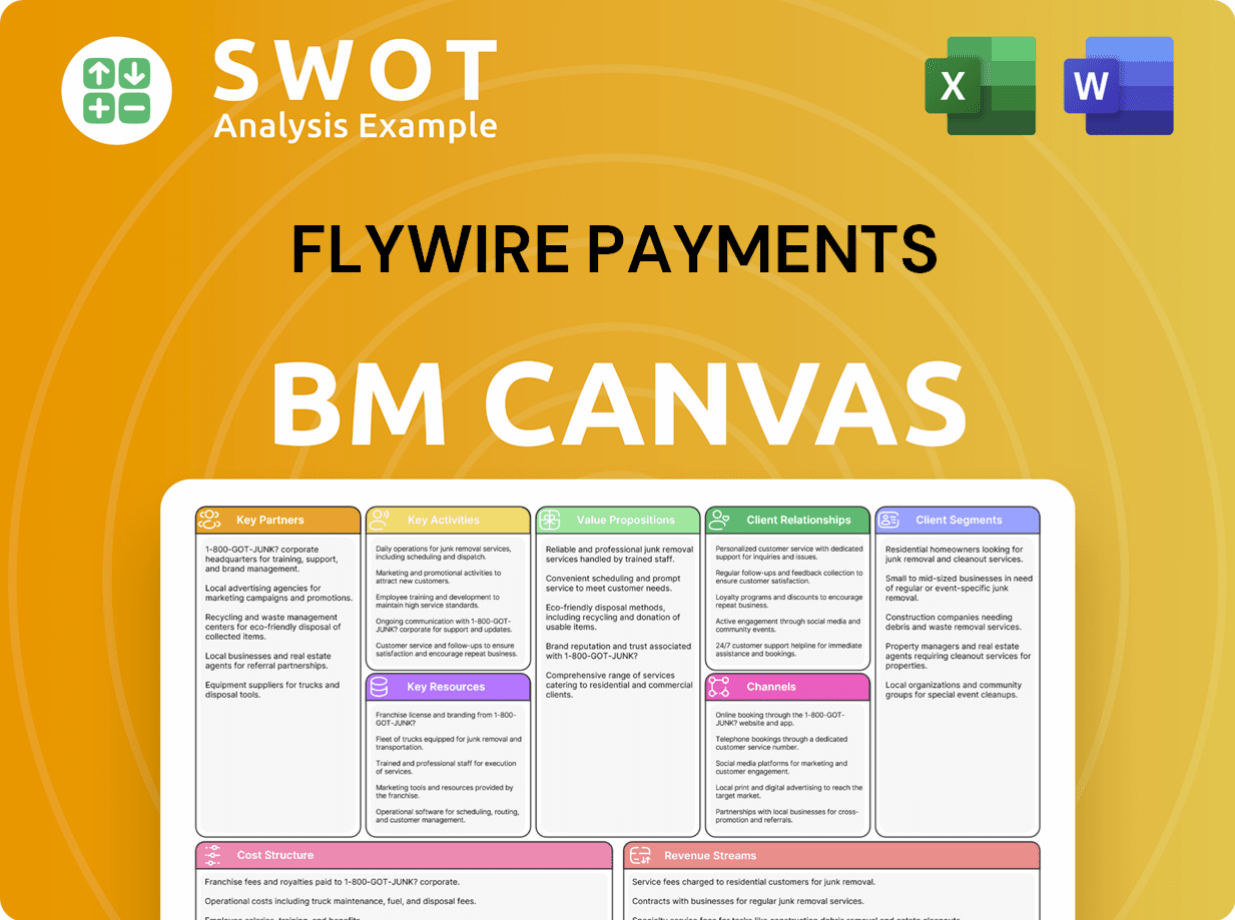Flywire Payments Bundle
Who Really Owns Flywire?
Understanding the ownership structure of a company is crucial for investors and strategists alike. Flywire, a global payments enablement and software powerhouse, has seen its ownership landscape evolve significantly since its inception. From its roots in simplifying international payments to its current status as a publicly traded entity, the journey of Flywire Payments SWOT Analysis is a compelling case study in corporate governance and stakeholder dynamics.

Founded by Iker Marcaide, Flywire, formerly known as peerTransfer, has become a leading Flywire payment solutions provider. This exploration into Flywire ownership will uncover the key players, from the Flywire founder to the major institutional investors, and how these shifts have influenced the Flywire company's strategic direction and financial performance. Discover the Flywire stock ownership details and gain insights into this publicly traded company's valuation and the individuals shaping its future.
Who Founded Flywire Payments?
The story of Flywire begins with its founder, Iker Marcaide, who established the company in 2009. Initially known as peerTransfer, the company's focus was on streamlining international tuition payments for students. While specific details about the initial equity distribution among the founders are not available, it is common for early-stage companies to allocate a significant portion of equity to the founders, often subject to vesting schedules.
Early investment played a crucial role in shaping Flywire's trajectory. The company secured funding from various investors, contributing to its growth and development. These early investments were instrumental in establishing the company's ownership structure and aligning the founding team's vision with the distribution of control.
Flywire, a prominent player in the payment processing industry, has evolved significantly since its inception. Understanding the company's ownership structure provides valuable insights into its journey and financial backing.
Iker Marcaide founded Flywire in 2009. His vision was to simplify international tuition payments for students.
The first funding round for Flywire occurred on October 28, 2010. Early funding was crucial for the company's initial growth.
Early backers and angel investors provided essential capital and support. Venture capital firms later joined in subsequent rounds.
Founders typically hold a significant portion of equity. Vesting schedules are common in early-stage companies.
Institutional investors like Spark Capital, Advent International, and Goldman Sachs participated in later funding rounds. These investments helped shape the company's ownership.
Flywire has raised a total of $263 million over nine funding rounds. This funding supported the company's expansion.
The ownership structure of Flywire, a leading Flywire payments company, has evolved since its founding. While the exact initial equity split among founders isn't publicly available, early-stage companies typically allocate a significant portion of equity to the founders. Flywire's journey, from its inception in 2009 to its current status, reflects a dynamic evolution in its ownership and investor base. The company's ability to secure funding, including raising a total of $263 million over nine rounds, has been key to its growth. This financial backing has played a crucial role in shaping the company's ownership structure and aligning the founding team's vision with the distribution of control.
Flywire Payments SWOT Analysis
- Complete SWOT Breakdown
- Fully Customizable
- Editable in Excel & Word
- Professional Formatting
- Investor-Ready Format

How Has Flywire Payments’s Ownership Changed Over Time?
The ownership structure of the Flywire company has transformed significantly over time. Initially a privately held entity, it transitioned to a publicly traded company. A key event in this evolution was the Initial Public Offering (IPO) on May 25, 2021. Shares began trading on the Nasdaq Global Select Market on May 26, 2021, under the ticker symbol 'FLYW'. The IPO involved the pricing of 10,440,000 shares of common stock at $24.00 per share, raising approximately $250.56 million.
This IPO marked a pivotal moment, shifting Flywire from private to public ownership. The offering allowed the company to access capital markets and broadened its investor base. The transition also introduced greater transparency and regulatory oversight, changing the dynamics of the company's financial and strategic decision-making processes.
| Ownership Category | Percentage of Ownership (May 2025) | Approximate Value (May 2025) |
|---|---|---|
| Institutional Shareholders | Approximately 85.58% | Varies based on stock price |
| Insiders | Around 5.51% | Varies based on stock price |
| Public Companies/Individual Investors | About 8.50% | Varies based on stock price |
As of May 2025, the ownership of Flywire stock is primarily distributed among institutional investors, insiders, and public companies/individual investors. Institutional shareholders hold a significant majority, with approximately 85.58% of the company's stock. Insiders hold around 5.51%, while public companies and individual investors own about 8.50%. These figures reflect the current distribution of ownership, highlighting the influence of institutional investors on the company's direction. Changes in these major shareholdings, such as those observed in Q3 and Q4 2024 where some institutional investors added or removed significant blocks of shares, can impact the company's stock price and strategic direction.
The major institutional stakeholders significantly influence Flywire's operations. These investors have considerable power regarding management and strategic decisions.
- Vanguard Group Inc., holding 9.49% with 11,530,428 shares, valued at approximately $119.69 million.
- Blackrock Inc., holding 7.32% with 8,896,748 shares, valued at approximately $92.35 million.
- Temasek Holdings Pte Ltd, holding 7.14% with 8,684,895 shares, valued at approximately $90.15 million.
- Bain Capital Venture Investors LLC, holding 7.24% with 8,795,388 shares.
- Cadian Capital Management LP, holding 5.78% with 7,029,707 shares.
Flywire Payments PESTLE Analysis
- Covers All 6 PESTLE Categories
- No Research Needed – Save Hours of Work
- Built by Experts, Trusted by Consultants
- Instant Download, Ready to Use
- 100% Editable, Fully Customizable

Who Sits on Flywire Payments’s Board?
The Board of Directors at Flywire, crucial for its governance, oversees the company's strategic direction and represents shareholder interests. As of June 2025, while a complete list isn't readily available, key figures in the leadership team, who often serve on the board, include Mike Massaro as CEO, Rob Orgel as President and COO, and Cosmin Pitigoi as CFO, who joined in March 2024. Other key leaders include Peter Butterfield (General Counsel & Chief Compliance Officer), David King (CTO), Allison MacLeod (CMO), Barbara Cousins (CIO, CISO & Internal Audit), and Mohit Kansal (Chief Payments Officer). These individuals are actively involved in investor communications, indicating their significant roles in decision-making and shareholder relations.
The company operates as a publicly traded entity on the Nasdaq Global Select Market, which suggests a standard one-share-one-vote structure for its common stock. There is no available information suggesting dual-class shares or special voting rights that would grant outsized control to specific individuals beyond their proportional equity ownership. The substantial percentage of stock held by institutional investors, approximately 85.58% as of May 2025, means their collective voting power significantly influences board elections and major corporate decisions. This structure encourages management to consider the interests of these large stakeholders in their strategic planning and governance. The Competitors Landscape of Flywire Payments provides further context on the competitive environment.
Flywire's Board of Directors is central to its governance, with key leadership figures playing significant roles. The company's structure, as a publicly traded entity, leans towards a one-share-one-vote system. Institutional investors hold a substantial portion of the stock, influencing corporate decisions.
- Key leaders like the CEO and CFO are actively involved in investor communications.
- The company's structure implies a standard voting system.
- Institutional investors' significant holdings influence corporate decisions.
- The leadership team includes individuals in key roles such as CEO, CFO, and COO.
Flywire Payments Business Model Canvas
- Complete 9-Block Business Model Canvas
- Effortlessly Communicate Your Business Strategy
- Investor-Ready BMC Format
- 100% Editable and Customizable
- Clear and Structured Layout

What Recent Changes Have Shaped Flywire Payments’s Ownership Landscape?
Over the past few years, several key developments have reshaped the ownership landscape of Flywire. The company's initial public offering (IPO) on May 26, 2021, marked a significant transition, introducing public shareholders into its ownership structure. This move was a pivotal moment for Flywire, transforming it from a privately held entity to a publicly traded company, thereby broadening its investor base and increasing market visibility. The IPO facilitated access to capital markets, enabling Flywire to fund its growth initiatives and strategic acquisitions.
In Q1 2025, Flywire demonstrated robust financial performance, which can influence investor confidence and, consequently, ownership trends. The company reported a 17% year-over-year increase in revenue, reaching $133.5 million. Total payment volume also saw a substantial rise of 20.4%, reaching $8.4 billion. Furthermore, Flywire showed improved profitability, with Adjusted EBITDA reaching $21.6 million in Q1 2025, nearly doubling from Q1 2024. These strong financial results reflect Flywire's solid market position and its ability to generate sustainable growth, attracting both institutional and individual investors.
| Metric | Q1 2024 | Q1 2025 |
|---|---|---|
| Revenue | $114.1 million | $133.5 million |
| Total Payment Volume (TPV) | $6.98 billion | $8.4 billion |
| Adjusted EBITDA | $11.3 million | $21.6 million |
Flywire has also been actively involved in a share repurchase program, which is a strategic move to return value to shareholders. As of March 31, 2025, the company had repurchased $93 million worth of shares out of a total authorized $150 million, with $49 million of those buybacks occurring in Q1 2025. This action reduces the number of outstanding shares, potentially increasing the ownership percentage of existing shareholders and boosting earnings per share. The company's commitment to share repurchases reflects its confidence in its financial health and its dedication to creating value for its investors. To learn more about Flywire's financial strategy, check out Revenue Streams & Business Model of Flywire Payments.
Institutional ownership in Flywire is significant, with approximately 85.60% of shares held by institutional investors as of May 2025. This high level of institutional ownership often suggests a level of stability and confidence in the company's long-term prospects.
Mutual funds have increased their holdings in Flywire, rising from 48.82% to 49.85% in May 2025. This indicates growing interest and confidence from these major investment vehicles, which can influence the stock's performance.
Flywire's share repurchase program, with $93 million of shares repurchased as of March 31, 2025, demonstrates a commitment to returning value to shareholders. This strategy can positively impact ownership percentages and earnings per share.
The acquisition of Sertifi, completed in Q1 2025 for $320 million, is expected to boost growth in Flywire's travel vertical. This expansion could lead to changes in the company's market presence and potentially influence ownership dynamics.
Flywire Payments Porter's Five Forces Analysis
- Covers All 5 Competitive Forces in Detail
- Structured for Consultants, Students, and Founders
- 100% Editable in Microsoft Word & Excel
- Instant Digital Download – Use Immediately
- Compatible with Mac & PC – Fully Unlocked

Related Blogs
- What are Mission Vision & Core Values of Flywire Payments Company?
- What is Competitive Landscape of Flywire Payments Company?
- What is Growth Strategy and Future Prospects of Flywire Payments Company?
- How Does Flywire Payments Company Work?
- What is Sales and Marketing Strategy of Flywire Payments Company?
- What is Brief History of Flywire Payments Company?
- What is Customer Demographics and Target Market of Flywire Payments Company?
Disclaimer
All information, articles, and product details provided on this website are for general informational and educational purposes only. We do not claim any ownership over, nor do we intend to infringe upon, any trademarks, copyrights, logos, brand names, or other intellectual property mentioned or depicted on this site. Such intellectual property remains the property of its respective owners, and any references here are made solely for identification or informational purposes, without implying any affiliation, endorsement, or partnership.
We make no representations or warranties, express or implied, regarding the accuracy, completeness, or suitability of any content or products presented. Nothing on this website should be construed as legal, tax, investment, financial, medical, or other professional advice. In addition, no part of this site—including articles or product references—constitutes a solicitation, recommendation, endorsement, advertisement, or offer to buy or sell any securities, franchises, or other financial instruments, particularly in jurisdictions where such activity would be unlawful.
All content is of a general nature and may not address the specific circumstances of any individual or entity. It is not a substitute for professional advice or services. Any actions you take based on the information provided here are strictly at your own risk. You accept full responsibility for any decisions or outcomes arising from your use of this website and agree to release us from any liability in connection with your use of, or reliance upon, the content or products found herein.